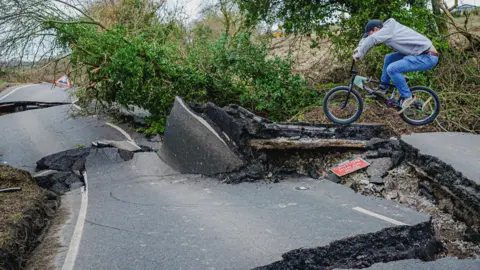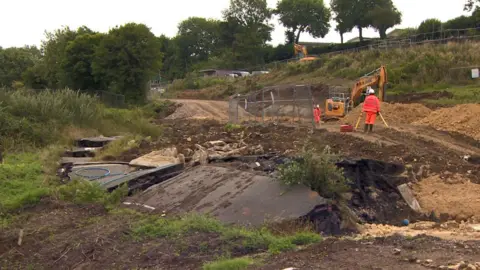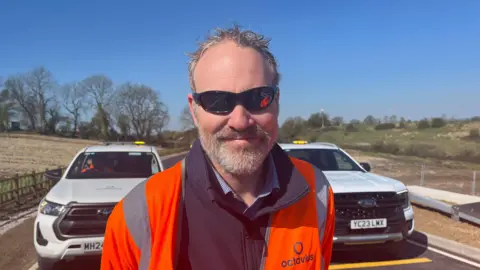The complex operation to fix 'UK's wonkiest road'
After three years and one month, 7,500 tonnes of stone and £5m spent, the road dubbed 'the UK's wonkiest' has been fixed - but why did it take so long to repair?
In February 2022 the B4069 Lyneham Banks in Wiltshire gave way, suffering a landslip after Storm Eunice.
It was closed and slipped even more, causing huge cracks in the surface and leading to it becoming a playground for BMX riders.
About 90 metres of the road was lost. That might not sound like much, but the fix has required some serious engineering - much more than just laying some tarmac.
In fact, the tarmacking and painting only took about a week. But what went before was far more complex, not least because the road was still slowly sliding away.
 PA Media
PA MediaWiltshire Council said it had to wait for the land to mostly stop moving before it could do much.
It also had to get a lot of ground investigations done, something the council has said was "absolutely necessary" and means the same problem should not happen again.
The new section of road and its supports has been designed to last around 120 years and took 25,000 work hours.

Contractors Octavius did the work, which the company perhaps understatedly described as "a challenge", starting in July 2024.
"The hillside was still creeping when we commenced work, and such ground conditions demanded some creative solutions," said Chris Hudson, operations director of Octavius' highways business.
Massive excavators and cranes were needed - something made trickier by being in a rural area with limited access to the site.
The repair crews also had extra issues with more wet weather and not wanting to make the slipping worse.
"We came with an initial plan - the access changed that plan several times. We adapted," said Mr Hudson.

He explained that masses of earth had to be taken away to make the area more stable.
Then a 108m-long huge retaining wall had to be put in place.
Big concrete pillars called bored piles - 120 of them - were put into the ground.
They go down 14 metres. To put that into perspective, most UK homes would not have foundations beyond a couple of metres into the earth.
A large beam was then put on top of those and the slope above and below the road was reshaped with new drainage, using 560m of drainage channels and grates and 1,000 tonnes of stone counterforts.
Altogether for the project, 650 cubic metres of concrete was needed and 2,370 bags of grout.
There have been finishing touches too - 600 new plants now run alongside the road.

The road would usually take around 5,500 vehicles a day, but for three years these have all been diverted through smaller villages.
Locals have said they are thrilled to have it re-open and Wiltshire Council has thanked the community for its patience
Follow BBC Wiltshire on Facebook, X and Instagram. Send your story ideas to us on email or via WhatsApp on 0800 313 4630.
